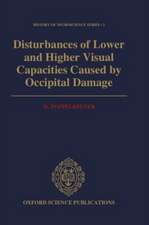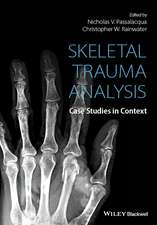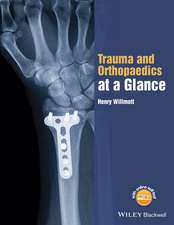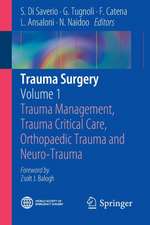Wound Healing and Skin Physiology
Editat de Peter Altmeyer, Klaus Hoffmann, Stephan El Gammal, Jerry Hutchinsonen Limba Engleză Paperback – 22 dec 1994
Themes include morphology and physiology, microcirculation and angiogenesis, biochemistry and immunology, microbiology and wound infection, non-invasive measurement techniques, wound repair, surgical treatment, dressings, and agents that promote wound healing.
Preț: 739.69 lei
Preț vechi: 778.63 lei
-5% Nou
Puncte Express: 1110
Preț estimativ în valută:
141.58€ • 153.84$ • 119.01£
141.58€ • 153.84$ • 119.01£
Carte tipărită la comandă
Livrare economică 22 aprilie-06 mai
Preluare comenzi: 021 569.72.76
Specificații
ISBN-13: 9783540561248
ISBN-10: 3540561242
Pagini: 736
Ilustrații: XV, 717 p. 173 illus.
Dimensiuni: 155 x 235 x 39 mm
Greutate: 1.01 kg
Ediția:Softcover reprint of the original 1st ed. 1995
Editura: Springer Berlin, Heidelberg
Colecția Springer
Locul publicării:Berlin, Heidelberg, Germany
ISBN-10: 3540561242
Pagini: 736
Ilustrații: XV, 717 p. 173 illus.
Dimensiuni: 155 x 235 x 39 mm
Greutate: 1.01 kg
Ediția:Softcover reprint of the original 1st ed. 1995
Editura: Springer Berlin, Heidelberg
Colecția Springer
Locul publicării:Berlin, Heidelberg, Germany
Public țintă
ResearchDescriere
On the occasion of the European Congress on Wound Healing and Skin Physiology (Bochum, Germany, November 1992), an international team of scientists and clinicians discussed the core topics in this important field of dermatological and surgical research.
Themes include morphology and physiology, microcirculation and angiogenesis, biochemistry and immunology, microbiology and wound infection, non-invasive measurement techniques, wound repair, surgical treatment, dressings, and agents that promote wound healing.
Themes include morphology and physiology, microcirculation and angiogenesis, biochemistry and immunology, microbiology and wound infection, non-invasive measurement techniques, wound repair, surgical treatment, dressings, and agents that promote wound healing.
Cuprins
I. History of Wound Healing.- Theory and Practice of Wound Healing in the Past.- De rara medicatione vulnerum: An Historical Approach to Wound Care.- II. Morphology and Physiology.- Fetal Wound Repair.- Histological Examination of Skin Grafts.- Reepithelialisation of Wounds.- Pathophysiology of Wound Healing in Venous Leg Ulcers.- Collagen Metabolism and Wound Contraction.- The Role of the Connective Tissue Matrix in Wound Healing: Fibroblast and Collagen Interactions.- Modulation of Fibroblastic Cytoskeletal Features During Wound Healing and Fibrosis.- III. Microcirculation and Angiogenesis.- Measurement of Microcirculation.- Spatial Pattern of Cutaneous Perfusion in Wound Healing.- The Vascular Architecture of the Keloid: A Scanning Electron Microscope Study on Vascular Corrosion Casts.- Growth Factor Control of Wound Healing Angiogenesis.- Blood Flow in Ulcerated Tissue and Surrounding Skin: Healing Correlates with Return of the Venoarteriolar Reflex.- Three-Dimensional Reconstruction of Terminal Blood Spaces in the Proximal Tibia Metaphysis of the Growing Rat — A Model to Study Normal Angiogenesis.- IV. Biochemistry and Immunology.- Trace Elements in Normal and Impaired Wound Healing.- Plasmin-Mediated Pericellular Proteolysis by Keratinocytes: Extracellular Matrix Reorganisation vs Tissue Damage.- Reduced Migration Potential of Epithelial Cells from Explants of Chronic Decubitus Ulcers: The Cause of Impaired Wound Healing?.- Fibronectin and Its Role in Wound Healing.- Mechanisms of Action of Collagenase in Wound Repair.- Studies of Growth Factor and Matrix Proteinase Activities During Early Stages of Wound Healing.- Regulatory Aspects of Collagen Synthesis in Fibroblasts from Human Colon and Skin.- Platelet Released Factors Stimulate Rat Burn Wound Contraction.- V. Experimental Studies.- Biologic Activity of Tissue Flaps in the Treatment of Complicated Wounds.- Studies on Wound Healing in Axial Pattern Flaps of the Diabetic Rat.- Endogenous Growth Factor Pathways May Regulate Epidermal Hyperplasia in Chronic Venous Wounds: Modulation by Hydrocolloid Dressings.- Immunohistochemical Effect of a Hydrocolloid Occlusive Dressing (DuoDERM E) in Psoriasis Vulgaris.- The Treatment of Malum Perforans Pedis: Operative and Conservative Therapy.- Phosphocreatine Ameliorates Structural Integrity of Ischemic Skin Flaps.- Granulocyte Activity Is Enhanced by Culture Supernatants of Mononuclear Leukocytes Incubated with Tetrachlorodecaoxide.- Skin Reactions and Sensations Induced by Intradermal Injection of Substance P into Compound 48/80 Pretreated Skin.- Effect of Wound Fluid on Cultured Keratinocytes.- Strategies of Keratinocytes and Fibroblasts in Wound Closure Observed in an In Vitro Model.- Interleukin-2 Improves Transfusion-Suppressed Repair of Experimental Intestinal Anastomoses.- Neuropeptides and Merkel Cells in Tissue Expansion.- Congenital Factor XIII Deficiency as Cause of Therapy-Resistant Burn Wounds.- VI. Microbiology and Wound Infection.- The Microbiology of Wounds.- Pathogenesis of Wound Infections.- Interaction of Bacteria with Host Defence Cells: Mechanisms of Burn Wound Sepsis.- Streptococcus pyogenes Induced Necrosis and Ulcers of the Skin: The Possible Role of Streptococal Exotoxins.- Inhibition of Wound Healing by Topical Anti-microbial Agents.- Intra-arterial Application of Ceftizoxime Supports Wound Healing in Infected Ischemic Lesions of the Limbs.- VII. Noninvasive Measurement Techniques.- Noninvasive Measurement of Wound Healing of the Skin.- Computerized Wound Analysis — A New Method for Assessment of Healing.- A Color Image Analysis System (CD-CWA) for the Quantification of Wound Healing in Multicenter Trials.- Noninvasive Assessment of the Physical Properties of the Skin.- Noninvasive Evaluation of Skin Barrier Function.- A Cellstick Device for Wound Healing Research.- High-Resolution Ultrasound Imaging of Various Types of Wounds.- A 20 MHz Ultrasound Examination of Lipodermatosclerosis.- Physiological Changes in Aging Skin.- Diagnosis and Treatment of Venous Diseases and Leg Ulcer.- VIII. Surgery and Physical Therapy of Wounds.- Wound Healing in Oncologic Dermatosurgery.- Treatment of Keloids and Hypertrophic Scars with Cryosurgery and Silicon Gel Sheeting.- Surgery of Venous Leg Ulcers.- Treatment of Venous Leg Ulcers with a Soft Laser Light.- IX. Dressings and Agents Promoting Wound Healing.- Dressings as a New Concept for Topical Treatment of Ulcers.- The Effect of Allopurinol on Wound Contraction and Granulation Tissue Formation in the Rat.- Effects of Pale Ichthyol in a Model of Impaired Wound Healing.- Pretreatment of Photodamaged Forearm Skin with Topical Tretinoin Accelerates Healing of Full-Thickness Wounds.- Treatment of Chronic Wounds with Cultured Keratinocytes.- Influence of Agents Used for Topical Wound Treatment on Phagocyte Stimulation and Fibroblast Growth.- Both Wet and Moist Wound Environments Accelerate Cutaneous Healing.- Comparative Experimental Study on the Treatment of Open Wounds.- Comparison of Varihesive E with the Conventional Tulle Gras Dressing in Skin Graft Donor Sites Treatment of Infants.- Hydrocolloid Dressings in the Therapy of Cryolesions.- Treatment of Venous Leg Ulcers Using Occlusive Hydrocolloid Dressings (Varihesive E) Versus Conventional Phase-Adapted Wound Dressing.- Weekly treatment of Psoriatic Plaques with the Hydrocolloid Dressing DuoDERM E in Combination with Triamcinolone Acetonide.- Covering Tattoo Dermabrasion Wounds with a Hydrocolloid Dressing (Varihesive E).- A Prospective Randomized Study of the Efficacy of Hydrogel, Hydrocolloid, and Saline Moistened Dressings on the Management of Pressure Ulcers.- Pericapillary Fibrin in Venous Ulcers Treated with Hydrocolloid Dressings.








